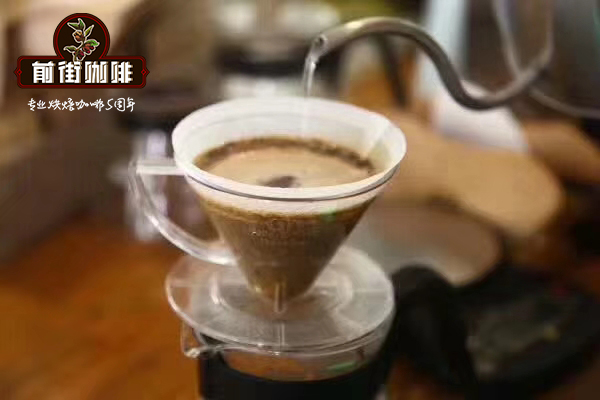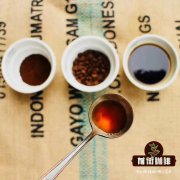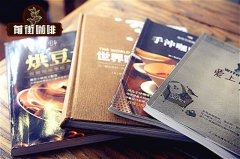Do you know the ratio of coffee to water? How to adjust the thickness of coffee?

Professional coffee knowledge exchange more coffee bean information please follow the coffee workshop (Wechat official account cafe_style)
The simplest form of coffee is to combine ground coffee powder with water. Whether the coffee we drink is bitter, sweet, delicious or hard to swallow, the key to determining these tastes depends on the quality of the beans, the water used, and the way they are combined. The combination method can be subdivided into: grinding thickness, cooking time, water temperature, cooking utensils and so on.
Of course, it also includes the "powder-to-water ratio", which, as the name implies, is the ratio of coffee powder to hot water, which affects the intensity and taste of coffee, so in this paper, we will discuss the importance of powder-to-water ratio on coffee.
Why is powder more important than water?
The flavor of coffee will change according to the brewing formula. The formula for brewing coffee is like the formula for baking cakes. The amount of each material used will be affected. As long as you increase or decrease the amount of water or coffee, you can change the taste and consistency of the coffee. As a result, many baristas or fastidious people will use scales and timers to assist in brewing coffee.
For example, some people will pour out multi-serving coffee with 50 grams of powder per liter of water. But some people talk about fixed proportions, such as 1:14 (14 ml water / g coffee powder) or 1:16 (16 ml water / g coffee powder)
Regardless of the ratio of powder to water, most people try to maintain its consistency, which means that the brewer can present his coffee in a more efficient and predictable way, and knows how to adjust the recipe if he wants to show a certain flavor.
The ratio of powder to water varies with the method of cooking.
Suppose you have a bag of high-quality beans on hand, and they are well baked, perhaps with obvious aromas of jasmine, red apple, round taste and honey sweetness. how would you make this coffee?
You have several choices: for many people, drip coffee is the ideal way to taste the nuances of coffee. Longer cooking time, lower concentration, clean taste.
Espresso, by contrast, is a short-brewed, strong drink that magnifies two or three main flavors of coffee. And these two kinds of coffee have different ideal powder-to-water ratio, grinding thickness, brewing time and other conditions.
Espresso: use very fine coffee powder with short brewing (usually about 25-30 seconds), using very little water, usually between 1:1 and 1:3. The concentration that takes a long time is called lungos, and the short one is called ristretto.
Generally speaking, soaked coffee (such as French filter pot, Philharmonic pressure or cup-tested coffee) uses thicker coffee powder and takes longer to brew. There are some differences in ideal grinding thickness and brewing time for dripping / hand-brewing coffee. Soaking and hand brewing require more water and coffee to brew. For example, you may see a powder-to-water ratio of 1:15 or 1:18. Soaked coffee usually requires less powder and water than hand-brewed coffee.
These descriptions can help you create your brewing recipe, but to find out the best way is to experiment on your own and try to make coffee with different ratios of powder to water.
Does the perfect powder-water ratio exist?
First of all, it is necessary to understand that different cultural backgrounds have their own preference for coffee brewing. Some countries prefer a delicate flavor, while others prefer a stronger flavor.
In addition, although many people will recommend different powder-to-water ratios, it still varies according to coffee.
So what powder-to-water ratio should be used? For example, if the drip coffee is 1:20, the whole cup of coffee will be too light; if it is 1:10, the coffee will be too strong. Both situations are extreme, and it is necessary to find the right balance for each cup of coffee. You will want to get aroma, acidity and all the delicate flavor in the coffee, so that you can enjoy the coffee.
In addition, some people will use bypass brewing, this method will first use less water to make coffee, get a higher concentration of coffee, and then dilute the coffee with water to prevent the coffee from being too strong to affect the taste.
The powder-to-water ratio is more than that.
Although the ratio of coffee powder to water is important, there are still some factors to consider: water quality, grinding particle size distribution, water temperature and even the mode of water injection.
If the coffee doesn't taste right, try to change one of the factors at a time without moving the others. The easiest thing to adjust is the grinding thickness:
If the coffee is too sour, salty or too thin, grind it down. This will increase the surface area of water contact, which in turn increases the extraction rate and makes the coffee closer to the result of sweetness and flavor.
If the coffee is too bitter, grind it a little bit. This will reduce the surface area of water contact, reduce the extraction rate, and prevent the release of too much bitterness during cooking.
Note: the extraction rate (the rate at which the substance of the coffee powder is released during brewing) and the cooking time (the total time the water is in contact with the coffee powder) sound a bit similar, but they actually mean different things, so be careful not to be confused.
It is not that easy to make good coffee, especially the dripping method, because there are too many different causes. But as long as you can control the cause, it's worth it, because you can drink the flavor written on the beanbag, such as jasmine, red apple, raspberry or honey.
When you control the extraction of coffee well, it means that you use the appropriate ratio of powder to water, grinding thickness and so on, so as to achieve the sweet spot that we pursue.
Important Notice :
前街咖啡 FrontStreet Coffee has moved to new addredd:
FrontStreet Coffee Address: 315,Donghua East Road,GuangZhou
Tel:020 38364473
- Prev

What is the function and function of caffeine? Security code for caffeine intake!
Professional coffee knowledge exchange more coffee bean information Please follow the coffee workshop (Wechat official account cafe_style) recently in the United States, it was reported that a 16-year-old boy drank three caffeinated drinks within two hours, resulting in sudden death of arrhythmia, which attracted public attention. Daily life is full of all kinds of caffeine drinks and foods, in addition to coffee, tea, energy drinks, food
- Next

How to avoid tooth staining caused by drinking coffee?
Professional coffee knowledge exchange more information on coffee beans Please follow the coffee workshop (official Wechat account cafe_style) people who drink coffee for a long time may find that your teeth are stained with coffee, because the tannins in the coffee accumulate on the enamel of the teeth, causing the teeth to change color. If your teeth have been stained with coffee, here are some ways to help reduce
Related
- Beginners will see the "Coffee pull flower" guide!
- What is the difference between ice blog purified milk and ordinary milk coffee?
- Why is the Philippines the largest producer of crops in Liberia?
- For coffee extraction, should the fine powder be retained?
- How does extracted espresso fill pressed powder? How much strength does it take to press the powder?
- How to make jasmine cold extract coffee? Is the jasmine + latte good?
- Will this little toy really make the coffee taste better? How does Lily Drip affect coffee extraction?
- Will the action of slapping the filter cup also affect coffee extraction?
- What's the difference between powder-to-water ratio and powder-to-liquid ratio?
- What is the Ethiopian local species? What does it have to do with Heirloom native species?

